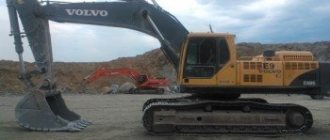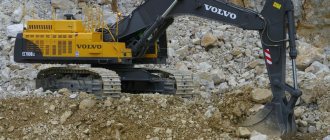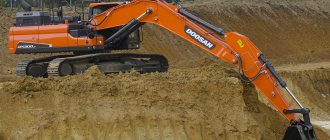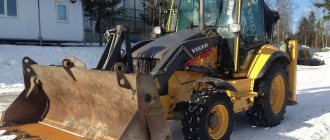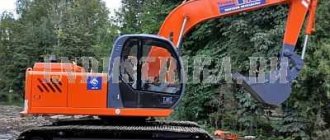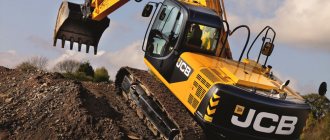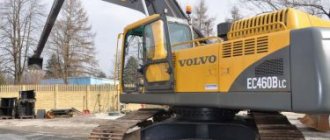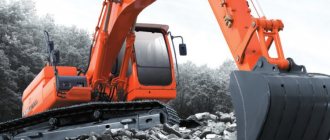The Volvo company is widely known for its cars and special equipment, characterized by high performance and safety. The production of special equipment is carried out by a special division of Volvo Construction Equipment or Volvo CE; it produces road construction machines, spare parts and components for them. Among the machines that have won wide recognition is the Volvo 240 excavator, whose technical characteristics have ensured its place on construction sites around the world. Volvo EC240BLC is a heavy-duty crawler excavator. Designed for digging holes, pits, trenches up to 14.35 m deep. In addition to construction and road work, it is used in the mining industry, quarrying, etc. It was produced from 2002 to 2007, but is still in demand.
Volvo EC 240 NLC User Manual and Operation
All new machines are sold with an excavator operating manual containing technical information, periods for replacing fluids and oils, grease, filter elements, and safety standards.
The operation of a Volvo excavator is no different from Hitachi excavators. Except for the ergonomics of the console panel. Fuel consumption is affected not only by power and engine size, but also by the operator’s work style, switching between normal and high-power modes.
Technical characteristics, specification of the Volvo EC 240 NLC excavator
- Average market price of an excavator, thousand rubles. — 8.40 million rubles.
- Cummins B8.3-C power unit
- Engine power 124 kW
- Maximum fuel consumption, liters/hour - 22.5
- Bucket volume up to 1.45 m3
- Load capacity (near the undercarriage) - 9 tons
- Digging radius - 10.3 meters
- Maximum digging depth 7000 mm
- Breakout force 151.1 kN
- Excavator weight - 23880 - 24800 kg
- Productivity, m/cub. — 360 (medium operating mode)
- Average fuel consumption, liters/hour - 14
- Minimum fuel consumption, liters/hour - 2.5
Features of operation
Advantages of Volvo EC240:
- Telemetry. These are control systems created using special technology. They allow you to measure drilling parameters during operation. Previously, measuring parameters such as whipstock position and wellbore characteristics required stopping work. The use of telemetry significantly reduces operating time, fuel consumption and increases the profitability of using an excavator. Included in the basic package of the Volvo 240.
- Economical. It is widely known that Volvo engines are characterized by low fuel consumption and environmentally friendly exhaust. Engines for special equipment also have high efficiency, performance and high torque at low crankshaft speeds.
- Improved hydraulic system. Combining flows from two hydraulic pumps reduces cycle time and increases productivity. Boom priority speeds up lifting of loads when mining at great depths, and turntable priority shortens the cycle. There is also a PowerMax operating mode, which increases the speed of movement of the working elements, and holding the handle and boom equipment, eliminating drift.
- Easy to maintain. Convenient access to the engine compartment and service hatches for the main functional units make servicing the excavator easier. Main service points are accessible from ground level and lubrication points are centralized.
- Safety. In addition to various sensors and fuses, the developers did not forget about simple things: the standard equipment includes reliable steel platforms and anti-slip pads, which allows you to work safely in any weather conditions.
- Comfort. Volvo's traditional priority is along with safety. Each vehicle is equipped with a comfortable Care Cab with rollover protection (ROPS safety frame), high-quality noise and heat insulation and a climate system.
- High degree of recycling. This means that most parts can be recycled, increasing environmental protection.
Volvo is a reliable construction equipment company
The driver works in comfortable conditions:
- Climate control
- Balanced control panel
- Clarity and consistency in operating equipment control
- Increased cab safety
- Unsurpassed visibility.
The Volvo EC 240 NLC hydraulic crawler excavator makes it easy to handle the toughest jobs:
- Working in difficult soils
- loading trucks on steep slopes
- Leveling on difficult soils.
Category: Volvo
Specifications
Options:
- weight – 24.3 t;
- capacity of the working body – 1300 l;
- standard bucket width – 3.19 m;
- digging radius – 9.69 m;
- digging force – 121.6 kN;
- digging depth - 6.98 m.
Engine – Volvo D7DEBE2:
- power – 119 kW / 159 hp;
- cooling – liquid;
- fuel – diesel;
- cylinders – 6;
- volume – 5.7 l;
- fuel tank volume – 360 l
Fuel consumption – 12 l/h (on average).
Dimensions:
- length – 10.02 m;
- width – 3.19 m;
- height – 2.99 m;
- track width – 0.6 m;
- weight – 24.3 t
Engine
Volvo installs its own engines on its vehicles. The EC240 excavator received a six-cylinder diesel engine D7DEBE2. The engine is turbocharged and has an auxiliary charge air cooler, which prevents overheating even when operating in hot weather and under heavy loads. The engine also has a direct fuel supply system. The engine capacity is 5.7 liters and the power is 119 kW (159 hp). Maximum engine torque is 730 Nm.
The equipment can work in various conditions
The company cares about environmental safety and pays special attention to emission standards. Excavators are equipped with a filter that filters up to 95% of harmful substances. The exhaust quality complies with Tier 2 and EUStage 2 standards. To reduce emissions and fuel consumption, at the buyer’s request, the engine is equipped with an automatic stop function and turns off if the equipment is inactive for longer than a certain time (for example, 5 minutes. 1 minute before the engine stops on the screen in the cabin a warning message appears.
Much attention is paid to the quality of the combustible mixture and its components. The charge air is cleaned in three stages, and the degree of dust in the filter is controlled by a special sensor. The fuel filter has a water separator. There are also electrical control and monitoring systems that optimize fuel consumption depending on the tasks performed.
Chassis
The undercarriage is an X-shaped frame with track chains. The movement of the tracks is carried out by a two-speed hydraulic motor of the axial piston type. The motor has a planetary gearbox, a recoil-reducing valve, and an automatic turntable braking system. Speed switching is automatic.
Cabin
The excavator operator is provided with comfortable and safe working conditions. Convenient access to the workplace and a large door make daily movements easier, and excellent visibility gives full control of the working parts. The windshield can be removed; for this purpose it is made of two parts: the lower one is removable, there is a compartment for it in the door trim, and the upper one is sliding, it can be raised to the ceiling.
The cab design is designed to provide decent working conditions in the toughest situations. Heating and air conditioning systems are included as standard. The ventilation system is also equipped with a filter to clean dusty air. Hydraulic shock-absorbing mounts absorb vibration and shock by 98%, and sound-absorbing upholstery significantly reduces noise.
Separately, it is worth noting the ROPS frame - protection against rollover. It is a system of structural elements that protect the operator in the event of equipment tipping over on its side. It consists of a subframe and a mounting device, and is also equipped with suspension or elastic shock absorbers.
The cabin is designed for driver comfort and safety
Additionally, a FOPS canopy can be installed to protect the operator from vertical loads (for example, falling boulders when working in a quarry). An important condition is that the seat belts are fastened - the system guarantees protection only in this case.
Also included in the cabin configuration is an ergonomic driver's seat with nine adjustment options, a spacious container for tools or personal belongings of the operator, convenient controls and a display that displays all key parameters: fuel consumption, position of working parts, etc.
Attachments
The following equipment is used with the excavator:
- The bucket is the main device used for working with bulk cargo. The bucket is used to dig holes, ditches, trenches, move cargo, carry out loading and unloading operations, and also use it to transport small-sized cargo over short distances.
- Rippers are designed to crush soil before digging trenches or other operations. They are made in the form of a claw or fang with a pointed “crown” of increased strength. It is used when working with heavy and frozen soils, compacted construction waste, etc. “Crowns” increase the penetrating ability of the ripper and are selected depending on the task.
- Grabs are various types of grips, shaped like jaws or flowers with opening petals. They are used for constructing wells and loading and unloading operations. Depending on the type of grip, they can work with long loads (pipes, logs) or bulk materials.
- The hydraulic hammer is used to open and dismantle road surfaces made of reinforced or asphalt concrete and frozen soils.
- Hydrodrill - equipment for making round holes in soil and asphalt concrete pavement. They are used for constructing pile foundations and fences, and drilling wells. This mechanism includes a drive device or head, a gear auger and extensions.
- Hydraulic shears are shaped like large pliers. They are mainly used for dismantling old buildings and structures. They have a turntable for easy control.
- Vibrating plates are used to compact soil. The most common area of application is road construction, construction of parking lots, airfields, and in some cases it is used to strengthen the soil for further work.
- Milling cutters are a type of equipment for grinding soil. The design is based on a drum with high-strength teeth. There are cutters for different types of soil, asphalt and concrete pavement.
- Mulchers are a type of special equipment for chopping branches, thin tree trunks and other plant debris. It is used when clearing glades and areas to destroy bushes and young growth, and also copes with pruning crowns. It is a rotor with movable and fixed teeth made of high-strength steel. The cutting teeth can have additional tungsten carbide coating, which increases service life and wear resistance.
- Stone-cutting saws are used in mining for clearing space, when constructing tunnels, and also when extracting stones. They are made of high-strength steel with a special coating, selected depending on the hardness of the rock.
Most Volvo excavators are equipped with attachments of our own production. Thus, Volvo CE designers have created a whole series of buckets made of high-strength steel and provided reliable protection of critical areas from overloads. Replacement elements are also available in an assortment: teeth, adapters, segments, side cutters, protective pads. The company also actively uses products from other manufacturers, for example, the British Miller, which produces attachments for Cat, Hitachi, JCB and others excavators.
Excavator Maintenance
Unlike the Russian tradition of the automotive industry, where one of the most important advantages of technology is “on-the-fly” repairs, European manufacturers have relied on high-tech mechanisms that require professional repairs. However, Volvo has done everything possible to make daily care and control of basic parameters easier for the operator. The hood is equipped with a convenient opening mechanism, and the main components are equipped with large service covers. Operations such as checking the oil or coolant level or inspecting the engine do not take much time.
Detailed information about excavator maintenance is found in the owner's manual and would require a separate article. Among the main works, the following can be noted.
Daily (performed every 10 operating hours):
- checking the oil level;
- checking the coolant level;
- checking the electrolyte level in the battery;
- checking the tension of the generator drive belt;
- cleaning the water separator.
Weekly (every 50 operating hours):
- adding lubricant to working units;
- checking and adjusting track tension.
Quarterly (every 500 operating hours):
- changing engine oil;
- turntable lubrication;
- radiator cleaning.
Volvo works with various attachments


